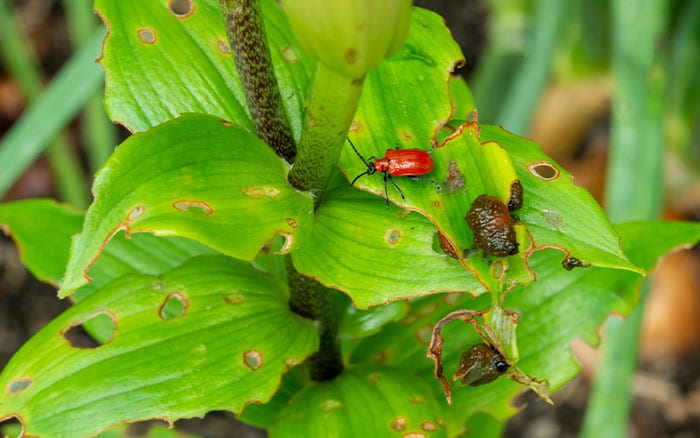Lily beetle, as its name suggests, affects lilies and fritillaries and is now widespread in Britain. Find out more about this pest in my handy pest and disease guide to lily beetles.
What are lily beetles?
Lilioceris lilii are one of the leaf beetle family. It’s also commonly called red lily beetle because of the distinctive red covering and to also differentiate it from other leaf beetles. All beetles in this family feed on plant leaves, hence their common name.
They tend to be found mostly on lilies and fritillaries and, as their family name suggests, are leaf eaters.
The good news is that plants will generally still flower well even after many of the leaves have been munched by the red beetle.
They are active from March until October but generally don’t tend to be seen on plants until early summer.
The adults are about 8mm long with a red body and black head and legs. They lay orange colour eggs on the underside of leaves, from which larvae emerge. In fact, it’s the larvae that do the most damage. The young will graze on the underside of the leaves. The older larvae eat the whole leaf starting from the tip and working backwards towards the stem.
The problem with a heavy infestation of lily beetle larvae on a plant is that they’ll eat so many of the leaves that the bulb may end up much smaller than it normally would at the end of the growing season. This could affect the plant’s ability to flower well or at all the following year.

How to control lily beetles
Regular close inspection of lily and fritillary plants from early spring onwards is the best way to avoid a build up the beetles and their larvae.
Pick adults off the plants by hand where you can.
If the infestation is not large and you’re able to keep an eye on them, leaving them could be a good option to allow a natural balance of predators to build up in your garden to control them for you.
Making your garden more wildlife friendly to encourage birds, ground beetles, wasps and frogs would be a great help as all of them will feed on the larvae.
Some lilies are sold as being lily beetle tolerant, such as ‘Defender Pink’.


Leave A Comment